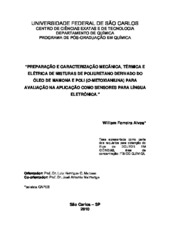| dc.contributor.author | Alves, William Ferreira | |
| dc.date.accessioned | 2016-06-02T20:34:21Z | |
| dc.date.available | 2010-10-19 | |
| dc.date.available | 2016-06-02T20:34:21Z | |
| dc.date.issued | 2010-07-28 | |
| dc.identifier.citation | ALVES, William Ferreira. Preparation and characterization mechanical, thermal and electrical mistures of polyurethane derived of castor oil and poly (o-methoxyaniline) for evaluation in the application for electronic tongue. 2010. 125 f. Tese (Doutorado em Ciências Exatas e da Terra) - Universidade Federal de São Carlos, São Carlos, 2010. | por |
| dc.identifier.uri | https://repositorio.ufscar.br/handle/ufscar/6170 | |
| dc.description.abstract | The incorporation of conducting polymer into a conventional polymer matrix has received considerable attention in the last decade because of the possibility of combining the good processability and mechanical performance of the conventional polymer with the electrical optical properties of conducting polymer. Among conducting polymers, polyaniline (PANI) and its derivatives has been extensively used because of the low cost of raw material, ease of synthesis and environmental stability. The main objective of this study was to develop a sensor for electronic tongue, from thin films of blends of polyurethane with POMA on interdigitated electrodes produced by spin-coating technique, under optimized conditions, and check the electrical behavior of the sensors in states doped. Films PUR mixture with POMA, although they may have less sensitivity to the substances found in the analyte than the nano-structured films, they may have better adherence and therefore be used to analyze substances with which the nano-structured films would not be possible. Films mixture of polyurethane derived from castor oil (PUR) and POMA were obtained by the casting (free standing) and also on interdigitated electrodes by the method of spin coating. The films were characterized using the techniques of UV-Vis-Nir, thermo-dynamic-mechanical analysis (DMTA), thermogravimetric analysis (TGA), stress-strain and optical microscopy. The values of modulus of elasticity of the PUR solvent chloroform (PUR-Clo) for the mixture of PUR/POMA (m/m) 50/50 had values of 0.3 GPa and 4.1 GPa, respectively. With the incorporation of 10% of POMA in the PUR glass transition temperature (Tg) of the films increased from 67 to 137oC, respectively. For the analysis done by DMA, the films with 30, 40 and 50% of POMA in PUR, confirmed the presence of crosslinking between the polymers, Mc, values of 195, 322 and 517 mol/m3, respectively. The films doped with NH4OH and HCl have better response capacitive and resistive to various analytes analyzed in the frequency range 1-105 Hz Thus, the sensors doped and dedoped can be used as an identifier of fingerprint detection of substances in different concentrations. | eng |
| dc.description.sponsorship | Financiadora de Estudos e Projetos | |
| dc.format | application/pdf | por |
| dc.language | por | por |
| dc.publisher | Universidade Federal de São Carlos | por |
| dc.rights | Acesso Aberto | por |
| dc.subject | Química | por |
| dc.subject | Misturas poliméricas | por |
| dc.subject | Sensores poliméricos | por |
| dc.subject | Análise térmica | por |
| dc.subject | Spin-coating | por |
| dc.title | Preparação e caracterização mecânica, térmica e elétrica de misturas de poliuretano derivado do óleo de mamona e poli (o- metoxianilina) para avaliação na aplicação como sensores para língua eletrônica | por |
| dc.title.alternative | Preparation and characterization mechanical, thermal and electrical mistures of polyurethane derived of castor oil and poly (o-methoxyaniline) for evaluation in the application for electronic tongue | eng |
| dc.type | Tese | por |
| dc.contributor.advisor1 | Mattoso, Luiz Henrique Capparelli | |
| dc.contributor.advisor1Lattes | http://lattes.cnpq.br/5839043594908917 | por |
| dc.description.resumo | A mistura de dois ou mais polímeros é uma alternativa para se obter um novo material que apresente propriedades desejáveis não encontradas nos componentes individuais. No caso da mistura de polímeros condutores com polímeros isolantes convencionais, tem-se como resultado, em geral, um terceiro material que apresenta boas propriedades mecânicas e alta condutividade elétrica que potencializam aplicações como sensores entre outras. O objetivo principal deste trabalho foi de desenvolver um sensor para língua eletrônica, a partir de filmes finos de mistura de poliuretano com POMA, sobre eletrodos interdigitados produzido pela técnica de spin-coating, sob condições otimizadas, e verificar o comportamento elétrico dos sensores e também a caracterização mecânica e térmica dos filmes auto-sustentáveis. Os filmes da mistura de Poliuretano derivada do óleo de mamona (PUR) e POMA foram obtidos pelo método casting (filmes auto-sustentáveis) e também sobre eletrodos interdigitados pelo método de spin coating . Os filmes foram caracterizados usando as técnicas de Uv-Vs-Nir, análise termo-dinâmicomecanica (DMTA), termogravimétrica (TGA), tensão deformação e microscopia óptica. Os valores de modulo de elasticidade do PUR com solvente clorofórmio (PUR-Clo) em relação à mistura de PUR/POMA 50/50 (m/m) apresentaram valores de 0,3 GPa e 4,1 GPa, respectivamente. Com a incorporação de 10% de POMA no PUR a temperatura de transição vítrea (Tg), dos filmes, aumentou de 67oC para 137oC, respectivamente. Pela analises realizadas através de DMA, os filmes com 30, 40 e 50% de POMA no PUR, confirmaram a presença de ligações cruzadas entre os polímeros, Mc, valores de 195, 322 e 517 mol/m3, respectivamente. Os filmes dopados com NH4OH e HCl apresentam melhores resposta capacitivas e resistivas para vários analitos analisados, na faixa de freqüência de 1 a 105 Hz. Assim, os sensores dopados e desdopados podem ser usados como um identificador de impressão digital na detecção de substâncias em diferentes concentrações. | por |
| dc.publisher.country | BR | por |
| dc.publisher.initials | UFSCar | por |
| dc.publisher.program | Programa de Pós-Graduação em Química - PPGQ | por |
| dc.subject.cnpq | CIENCIAS EXATAS E DA TERRA::QUIMICA | por |
| dc.contributor.authorlattes | http://lattes.cnpq.br/1312419546878025 | por |
